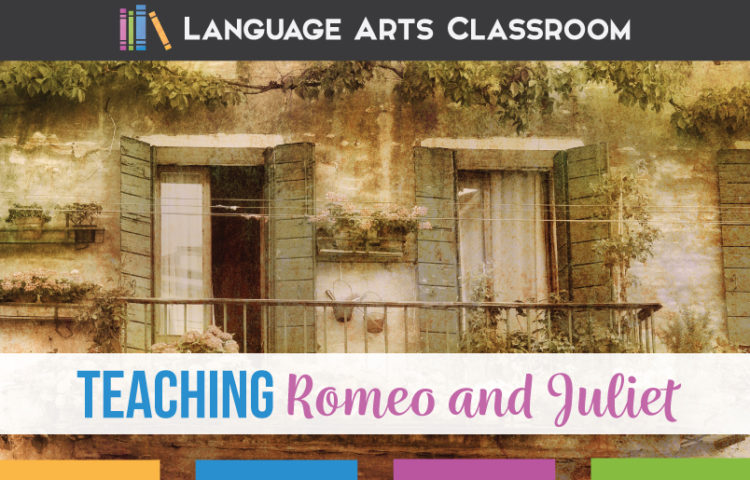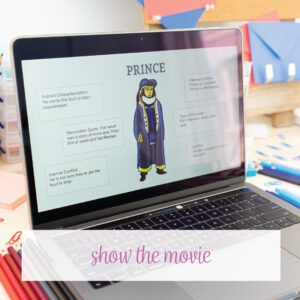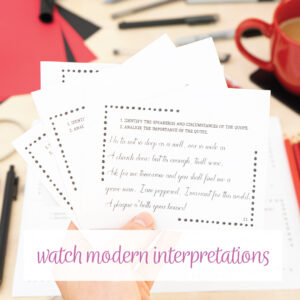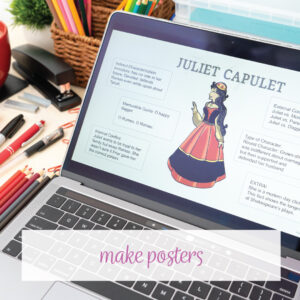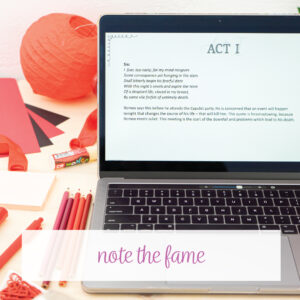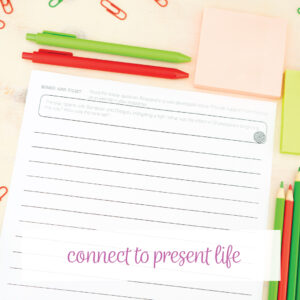Looking for Romeo and Juliet lesson plans? Typically, teaching Romeo and Juliet in ninth grade is part of teaching freshmen. If you need Romeo and Juliet assignments, I wrote several out for you and provided a free planning sheet for you. So many ideas exist, you can organize yours with the free download.
My feelings are mixed about teaching this love story. Is this a love story? My students typically comment that Romeo and Juliet is a bad rom-com, and I find that approach hilarious. It also reminds me why I love teaching teenagers.
I have taught Romeo and Juliet… dozens of times? I’ve created lessons that have bombed and directed less than enthusiastic students through lines; I’ve met standards and realized that I should have done way better.
And! I’ve scored too! Since I’ve taught Shakespeare’s famous play so many times, I can report to you what has worked and not worked. You can take this information and make it your own. So… here is where I’ve found success when creating Romeo and Juliet lesson plans.
Provide background.
Brain-based learning research tells teachers to provide background before starting a unit. I created a concept map where students have the flexibility to choose their research area. Typically, students study about Shakespeare’s life, his writings, the English Renaissance, and Shakespeare’s enduring fame.
Some students become enthralled with the Elizabethan time period. People had strange outfits and wore lead makeup. I like using concept maps because students can choose an area to study as they find interesting topics. Great Romeo and Juliet introduction activities can set your unit for a positive tone.
Students who might not love reading the play often find the historical aspects interesting. I try to grab their attention that way.
Acknowledge the romance.
I’m jaded and internally roll my eyes when I read Romeo and Juliet. (They. Just. Met.) Young students enjoy the romance, and I capitalize on that.
Since high school students date and watch shows with romantic storylines, I poke at Romeo and Juliet’s relationships. Debate the existence of love at first sight. Discuss parental involvement in dating. How do friends treat each other with the onset of a new relationship? Students connect to the conflicts Romeo and Juliet face, and they see that Shakespeare’s plays still have a purpose.
Students often tell me about characters from graphic novels, movies, and shows who fall in love quickly. We discuss the repetitive themes humans explore.
Show the movie first.
A teacher mentioned this trick at a conference, and I tried it last year. I’ve always utilized the movie as we studied the play, but my students and I never completed the movie first.
This order makes sense: Shakespeare wanted the material viewed, not simply read. As we study it, we’ll of course read it. Now, we watch the movie and then reference the actors and setting from the movie.
The students are often nervous to study Shakespeare, but having a visual in their heads help. The clothes, the gestures, the setting… it is so strange to modern teenagers. Seeing the play first, and then studying and reading it makes a huge difference in interest levels and comprehension.
Plus, students are more confident as we proceed in reading the play. Watching some version, the play or a movie version, is an important part of Romeo and Juliet lesson plans.
Write and write.
I keep a handful of writing prompts on hand, but often, class discussions dictate what students will write. We choose from interesting characters, complex conflicts, or foreshadowing. We analyze quotes and literary devices. Through writing, students discover deeper meanings and ask questions.
Shakespeare’s plays are dense. When students write about the information, they process it. They work through complications and are more likely to ask me clarifying questions.
Many Romeo and Juliet assignments can branch from short writing assignments. Look what students develop and find interesting.
Watch modern interpretations.
What would Romeo say in an interview? Is the Friar confused by the basic facts? For extension activities, My Shakespeare is a wonderful resource that will put Romeo and Juliet in a fresh light. (I want to gush about it. That website is golden.)
Plus, My Shakespeare provides great Romeo and Juliet introduction activities. The videos clarify the setting, plot, and author.
As a fun alternative, students can translate portions of the play into graphic novel pages or short videos.
Highlight the language.
Romeo and Juliet is not my favorite Shakespearean play, but that final line is stunning: “For never was a story of more woe Than this of Juliet and her Romeo.” All of the language is purposeful, specifically, the iambic pentameter. Use this video to explain the concept.
The language and the beauty of the devices deserves study. Students and I frequently make a word wall with the literary devices and their definitions. We can reference them as we continue reading the play.
Make posters.
The numerous characters have odd names, and students need to keep them organized. I ask students to create a “Capulet” wall and a “Montague” wall. As we study the play, we reference the walls, especially as the families interact and people start to die. These simple posters keep the characters organized.
I also use digital designs to analyze characters. Those can be printed as well.
Show the comedy.
Romeo and Juliet is a tragedy, but parts are hysterical. My favorite line? “Saucy boy.“ Dependent upon your students, highlight highlight lines from Nurse and Mercutio where appropriate. Doing so shows the depth of Shakespeare.
You can easily find Shakespeare insult generators online too.
Note the fame.
In my introduction to Romeo and Juliet, I ask students what they know about the play. Students know the lines, “Oh Romeo, Romeo wherefore art thou Romeo?” and “What’s in a name? That which we call a rose by any other name would smell as sweet.” Students know these lines because the play is famous. They are studying a famous piece of literature! That fact is powerful.
Connect to present life.
Shakespeare endures because humans today see themselves in his literature. Do some families argue and not get along? Has a parent ever told a child not to marry or date someone? Do teenagers become upset about lost love? Is miscommunication a problem? Do adults mess up situations? When students relate the ideas to their lives, they will appreciate the play on a new level.
There you have it: ten ideas to implement in your Romeo and Juliet lesson plans. I hope these ideas inspire you to personalize your Romeo and Juliet unit for your students.
Are you interested in more specific ideas for other common stories? I have free ideas for Animal Farm, The Hunger Games, and Julius Caesar.
Would you like to discuss more Romeo and Juliet activities? My Facebook page connects thousands of educators.

